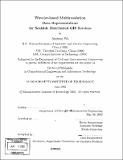Wavelet-based multiresolution data representations for scalable distributed GIS services
Author(s)
Wu, Jingsong, 1972-
DownloadFull printable version (11.45Mb)
Other Contributors
Massachusetts Institute of Technology. Dept. of Civil and Environmental Engineering.
Advisor
Kevin Amaratunga.
Terms of use
Metadata
Show full item recordAbstract
Demand for providing scalable distributed GIS services has been growing greatly as the Internet continues to boom. However, currently available data representations for these services are limited by a deficiency of scalability in data formats. In this research, four types of multiresolution data representations based on wavelet theories have been put forward. The designed Wavelet Image (WImg) data format helps us to achieve dynamic zooming and panning of compressed image maps in a prototype GIS viewer. The Wavelet Digital Elevation Model (WDEM) format is developed to deal with cell-based surface data. A WDEM is better than a raster pyramid in that a WDEM provides a non-redundant multiresolution representation. The Wavelet Arc (WArc) format is developed for decomposing curves into a multiresolution format through the lifting scheme. The Wavelet Triangulated Irregular Network (WTIN) format is developed to process general terrain surfaces based on the second generation wavelet theory. By designing a strategy to resample a terrain surface at subdivision points through the modified Butterfly scheme, we achieve the result: only one wavelet coefficient needs to be stored for each point in the final representation. In contrast to this result, three wavelet coefficients need to be stored for each point in a general 3D object wavelet-based representation. Our scheme is an interpolation scheme and has much better performance than the Hat wavelet filter on a surface. Boundary filters are designed to make the representation consistent with the rectangular boundary constraint. (cont.) We use a multi-linked list and a quadtree array as the data structures for computing. A method to convert a high resolution DEM to a WTIN is also provided. These four wavelet-based representations provide consistent and efficient multiresolution formats for online GIS. This makes scalable distributed GIS services more efficient and implementable.
Description
Thesis (Ph.D.)--Massachusetts Institute of Technology, Dept. of Civil and Environmental Engineering, 2002. Includes bibliographical references (p. 155-160).
Date issued
2002Department
Massachusetts Institute of Technology. Department of Civil and Environmental EngineeringPublisher
Massachusetts Institute of Technology
Keywords
Civil and Environmental Engineering.